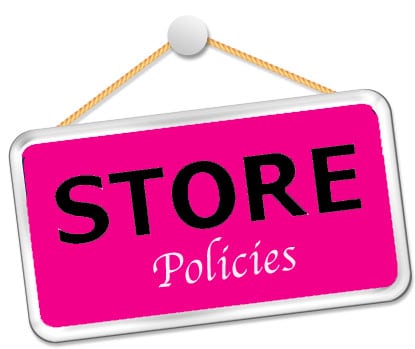Setting up an online store site is easy these days. Keeping your site safe from hacking, fraud and copycats, not so much. And as small business owners know all too well, one major breach – or too many charge backs or someone stealing your business name or copying your products – could mean the end of your business.
Here are 5 tips for ecommerce business owners can protect their online stores from hacking, fraud and/or copycats.
1. Create and post your store policies.
Before you start accepting eCommerce sales, clearly post your shipping policy, return policy, and terms of service on your website to ensure that you and your customers are on the same page from the start. A return policy helps to manage customer expectations by answering the following questions:
- How long does a customer have to return an item?
- What is the procedure for a return or exchange? How do customers contact you, and how long does the process take?
- Who pays to return items back to you?
- Are there any items that are not returnable, such as sale items or items that have been opened or used.
- Do you offer full refunds, exchanges, or store credit?

2. Run a test payment.
Run a test payment to identify what information is available to you in your ecommerce dashboard. Reviewing your customer’s information to verify an order’s authenticity is an important step to take before shipping out goods. Knowing ahead of time where to locate declined eCommerce payments, as well as customer information, helps to streamline your review process.
3. Use HTTPS
Online security is paramount to a website’s success. You’ve heard the buzzwords: online privacy, cybercrime, malware, phishing, censorship, DDoS attacks, and so on. These issues periodically pester online users, some more than others, of course.
An essential to shielding yourself and your site against these security vulnerabilities is the end-to-end encryption of the communication data between computers (PC, phone, etc.) and web servers.
We live in an increasingly digitally connected world, where the Transport Layer Security (TLS) network protocol is of the utmost importance to safeguarding folks from digital harm.
The TLS protocol is used by the HTTPS protocol (among others) to encrypt and authenticate the computers involved in any communication on the web.
4. Keep a paper trail.
Keeping good records is a good business practice, but it’s essential when goods or services are exchanged online. If a customer initiates a dispute, your only available recourse is to provide proof that the order was fulfilled.
Be ready to provide all the supporting information about a disputed transaction so that Square can challenge the claim with the cardholder’s bank on your behalf. Keep tracking information for shipping and delivery. Square’s built-in eCommerce tools automatically save shipping and fulfillment details for easy retrieval. Require a signature upon receipt for large orders. Itemize your receipts to show exactly what was sold, and keep any email between you and your customer for 18 months.
5. Monitor declines.
Credit card issuers mitigate fraud by declining payments that look out of line, either geographically or contextually against other card activity. You can check your own declined payment history to help spot a potential problem.
When you receive an order from a new customer — particularly if it’s a large payment — navigate to your eCommerce sales history on your Square Dashboard and select Transaction Status from the sidebar. Look for recently declined payments of the same amount within a short span of time.
Conclusion
I hope the article above can help you to prevent fraud in your online store. Imagine if your website is already well-known, you also have to think about the security on your system. With good security, your e-commerce website can always run smoothly.